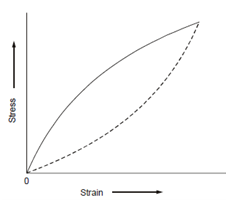Rubber:
When a rubber cord is stretched to over several times its original length, it regains its original length when the stretching force is removed. The stress- strain curve for rubber is shown in Figure 25. You may note that this curve is distinctly different from that for a metal wire (Figure). For example, no part of this curve is linear, that is, stress is not proportional to strain in any region of the curve. Secondly, when the deforming force is removed, the cord acquires its original length. However, the work done by the cord material in returning to its original length is less than the work done by the deforming force in deforming it. As a result, certain amount of energy is absorbed by the material in each cycle of stretching and the return back to its original length. This energy appears as heat and the phenomenon is called elastic hysteresis.

Figure: Stress-Strain Curve for Rubber
Elastic hysteresis has an important application in shock absorbers. A part of energy transferred by deforming force is absorbed by the shock absorber and only a small part is transmitted to the body.
Experimental results similar to those discussed above clearly indicate that stress and strain of a material are related to each other. First successful attempt to establish the relation between these two parameters was made by Robert Hooke who proposed a law for this purpose.